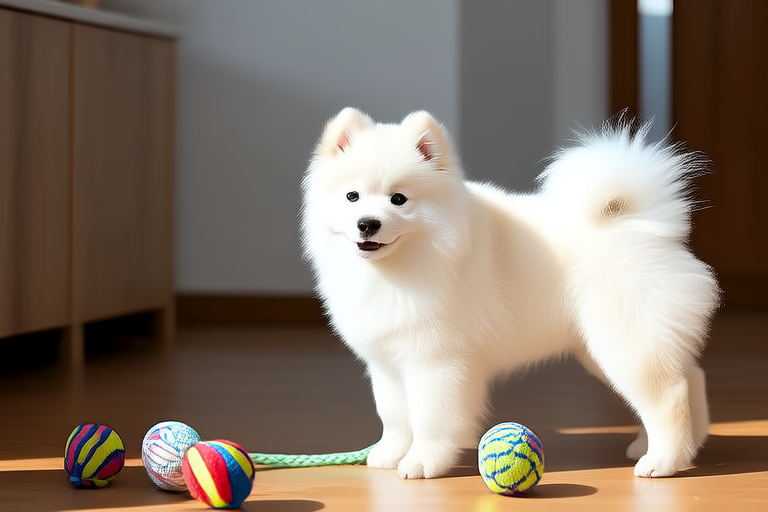The Ultimate Guide to Training Your Playful Samoyed Pup
Welcome to the world of Samoyed ownership! Known for their fluffy white coats and friendly demeanor, Samoyeds are popular family pets. However, their playful nature can sometimes make them challenging to train. This guide will help you understand how to effectively train your Samoyed pup, ensuring a happy and well-behaved companion.
Essential Training Tips
Training a Samoyed requires patience, consistency, and positive reinforcement. Start by establishing clear boundaries and rules from day one. Use treats and praise to reward good behavior, but avoid harsh punishments. Remember, Samoyeds are intelligent and sensitive, so gentle guidance works best.
Begin with basic commands like ‘sit,’ ‘stay,’ and ‘come.’ Break down each command into simple steps and practice in short, frequent sessions. For instance, to teach ‘sit,’ hold a treat above your puppy’s head and say ‘sit’ as they naturally lower their bottom. Once they sit, give them the treat and praise them enthusiastically.
Common Behaviors
Samoyeds are known for their love of play and attention-seeking behavior. They often bark or jump up when excited, which can be endearing but may also become problematic if not managed properly. It’s important to redirect this energy into appropriate activities like fetch or tug-of-war games.
Another common behavior is chewing. Provide plenty of chew toys and supervise your puppy closely until they learn what is acceptable to chew on. Crate training can also be helpful in preventing destructive chewing, as it gives your puppy a safe space to relax and rest.
Effective Positive Reinforcement Techniques
Positive reinforcement is key to successful training. Reward your Samoyed pup with treats, praise, and affection whenever they exhibit desired behaviors. Be consistent and timely with your rewards, as delayed feedback can confuse your puppy.
For example, if your Samoyed sits on command, immediately give them a treat and say ‘good boy/girl!’ This reinforces the connection between the action and the reward, making it more likely that your puppy will repeat the behavior in the future. Additionally, consider using clicker training, where a clicker is used to mark the exact moment your puppy performs the correct action, followed by a treat.
Exercise Needs
Samoyeds are an active breed that requires regular exercise to maintain physical and mental health. Aim for at least two hours of activity per day, including walks, runs, and playtime. Incorporate variety into their routine to keep things interesting, such as hiking, swimming, or agility training.
Real-life example: Sarah, a Samoyed owner, noticed her puppy became overly energetic and difficult to manage after a long day without exercise. She started taking her dog on daily hikes, which not only improved their fitness but also strengthened their bond. Now, both enjoy their outdoor adventures together.
Grooming Specifics
Grooming is essential for maintaining your Samoyed’s beautiful coat. Brush them regularly, ideally daily, to prevent matting and remove loose hair. Bathe them every few months or as needed, using a gentle dog shampoo. Pay special attention to their paws, ears, and eyes during grooming sessions.
Expert advice: Dr. Emily Carter, a veterinarian specializing in canine dermatology, recommends using a slicker brush for removing tangles and undercoat rake for deep cleaning. She advises against over-bathing, as it can strip natural oils from the skin.
Diet Recommendations
A balanced diet is crucial for your Samoyed’s overall health. Choose high-quality dog food that meets their nutritional needs. Consult with your vet about portion sizes and feeding schedules based on your puppy’s age, weight, and activity level.
Consider adding supplements like omega-3 fatty acids for skin and coat health. Avoid human foods that can be harmful to dogs, such as chocolate, grapes, and onions. Real-life example: John, a Samoyed owner, noticed his puppy’s coat became dull and dry after switching to cheaper dog food. He switched back to premium food and added fish oil supplements, resulting in a healthier, shinier coat.
Socialization Strategies
Socializing your Samoyed pup early helps them develop confidence and good manners around other people and animals. Expose them to various environments, sounds, and experiences while they’re young. Invite friends over, take them to parks, and introduce them to different types of people and pets.
Real-life example: Lisa, a Samoyed owner, took her puppy to a local pet store for socialization. Initially shy, the puppy gradually became more comfortable with new surroundings and interactions. Lisa now has a well-adjusted dog who enjoys meeting new people and animals.
Troubleshooting Common Training Challenges
Despite your best efforts, some challenges may arise during training. Here are solutions to common issues:
- Barking: Identify the cause of barking (e.g., boredom, excitement) and address it accordingly. Teach your puppy a ‘quiet’ command by rewarding them when they stop barking on command.
- Chewing: Provide plenty of chew toys and redirect your puppy’s attention when they start chewing on inappropriate items. Praise them when they chew on the right toy.
- Potty training: Establish a consistent schedule and take your puppy outside frequently. Reward them with treats and praise when they eliminate in the designated area.
- Separation anxiety: Gradually increase the time your puppy spends alone to build their independence. Consider leaving a familiar item, like a blanket, for comfort. Seek professional help if necessary.
Real-life example: Mike, a Samoyed owner, struggled with his puppy’s separation anxiety. He began leaving the TV on for background noise and gradually increased the time he left his puppy alone. After several weeks, his puppy became more comfortable being left home alone.
Conclusion
Training your Samoyed pup requires patience, dedication, and love. By following these tips and strategies, you’ll be well on your way to raising a well-behaved, happy, and healthy Samoyed. Remember, every puppy is unique, so adapt these guidelines to suit your individual dog’s needs. With proper care and training, you’ll enjoy many years of companionship with your beloved Samoyed.
